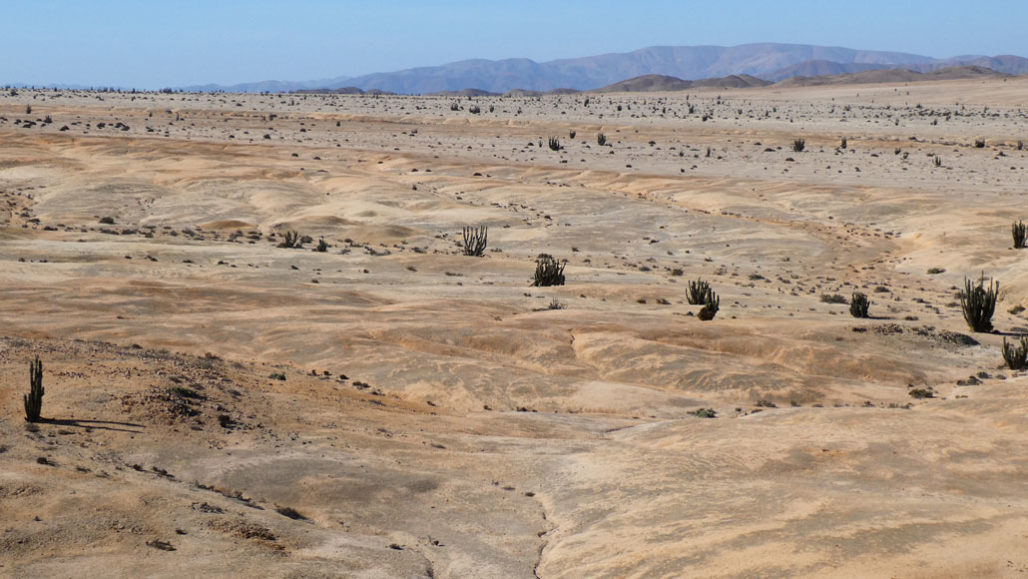Newfound desert soil community lives on sips of fog
Lichens and other fungi and algae team up to form a ‘grit-crust’ on ultra-dry soil

Scientists have discovered a hardy form of biological soil crust that survives on coastal fog in northern Chile. This “grit-crust” creates black and white splotches across the land in Pan de Azúcar National Park (shown).
P. Jung
By Jack J. Lee
What may be the planet’s hardiest desert dwellers have been hiding in plain sight. These lichens and other fungi and algae have united to form a “grit-crust” atop the parched surface of northern Chile’s Atacama Desert.
This newly discovered group of organisms coats tiny stones. It draws moisture from daily pulses of coastal fog that roll across the world’s driest nonpolar desert. Sunlight fuels these grit-crust communities. They use photosynthesis to make sugars. But they do it best using less than half as much water as other known desert soil-crust communities. That’s the conclusion of researchers who shared their findings December 16 in Geobiology.
Their “super cool” find suggests that soil communities can eke out a living in the planet’s harshest settings, says Jayne Belnap. She was not involved in the study. An ecologist, she works for the U.S. Geological Survey in Moab, Utah.
Biological soil crusts — also known as biocrusts — are communities of algae, cyanobacteria, lichens, fungi or mosses. They cover about one-eighth of the land on Earth. Commonly found in deserts, they can blanket the soil and prevent erosion. They also can shape ecosystems. They do this by drawing carbon and nitrogen from the air and moving it into the ground. Along the way, they release oxygen via photosynthesis.
Only a few millimeters of rain dampen the Atacama most years. But some areas experience daily cycles of fog and dew. One such “fog oasis” exists about 2.5 kilometers (1.6 miles) from the Pacific Coast. It’s in Pan de Azúcar National Park. That’s north of Santiago, Chile. Here, researchers spotted odd markings.
“We got there with our cars and saw these blackish and whitish patterns in the landscape,” recalls Patrick Jung. He’s a botanist who works at University of Applied Sciences Kaiserslautern. That’s in Germany.
Previous surveys had turned up other biocrusts in the Atacama. But the new crusts were different. Other biocrusts form as layers on top of soil surfaces. Grit-crust instead forms on and around tiny, 6-millimeter (0.2 inch) pebbles.

The researchers found that grit-crust is made up of a mix of lichens, fungi, algae and cyanobacteria. Together, they can coat pebbles and even serve as a glue that attaches small rocks to each other. This creates a structure that’s something like a rock-based peanut brittle.
This grit-crust is “something different that we’ve not seen before,” observes Matthew Bowker. Bowker is an ecologist at Northern Arizona University in Flagstaff who did not take part in this study.
Designed for the dry life
In lab experiments, the researchers measured the rate at which the crust communities consumed carbon dioxide. This varied as moisture levels changed. Photosynthesis peaked when a sample had just 0.25 millimeter (0.01 inch) of water. That’s about equal to 250 milliliters (10 inches) of water spread over one square meter (10.8 square feet) of grit-crust. That amount of moisture is within the range expected from deposits by daily fog banks near the coast.
In comparison, biocrusts of the Sonoran Desert, which is found in Mexico and the U.S. Southwest, need two to four times as much water to photosynthesize at peak levels.
A microscopic survey showed that fungi associated with the grit-crust were tunneling into the rocks from the surface. Their tubular growth structures — or hyphae (HY-fee) — swell and shrink with the flow of fog. This action serves to crack and eventually break up the stones. Such a “biological weathering” is the only process known to create new soil in the Atacama Desert, Jung and his coworkers say. Long ago, such grit-crusts may have transformed the harsh surface of ancient Earth by breaking down rock to make soil. These communities also could have been storing carbon in the ground and producing oxygen, all before photosynthetic plants arose.
This is not the first time scientists have seen fungi or plants burrowing into rock. For instance, some mountain shrubs in Brazil use acids released by their roots to get at rock minerals. Earlier research also has turned up lichens surviving in fog deserts. However, Belnap says, the newfound grit-crust is “a novel composite of those processes.”
Similar crusts probably live in other fog deserts, Jung says. He and other researchers plan to search for them in the coastal Namib Desert of southern Africa. There, others have already spotted the telltale black-and-white patterns.







